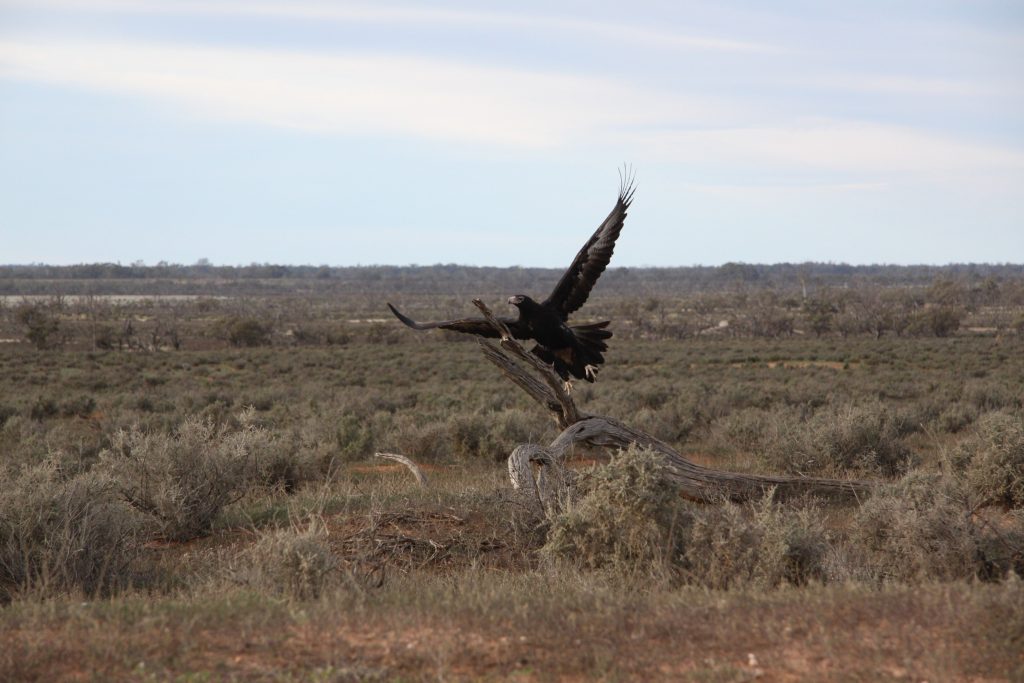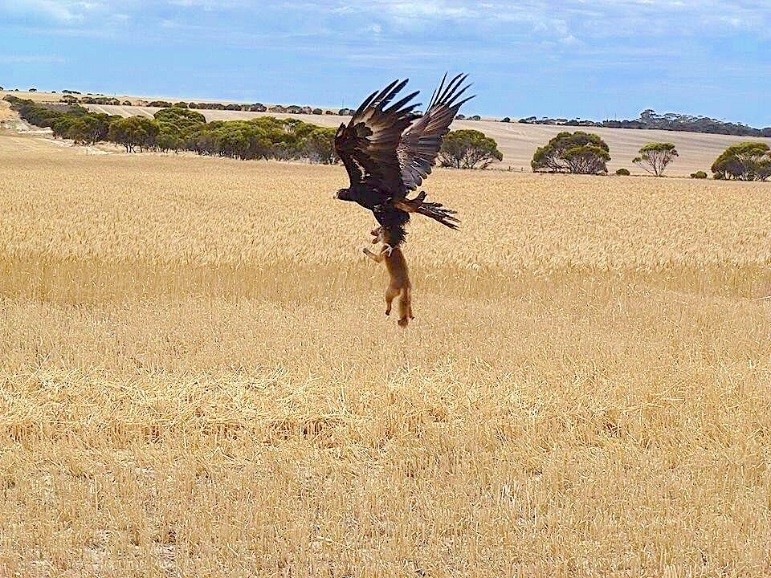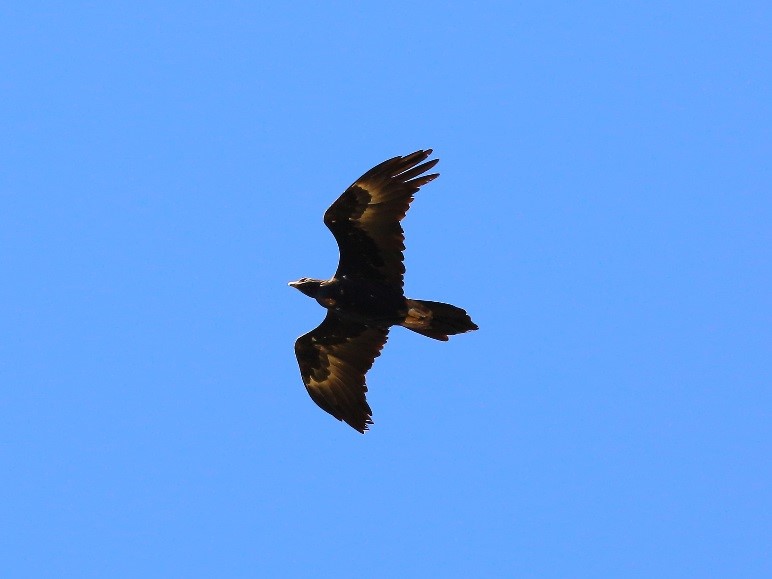Living with wedge-tailed eagles and enhancing the benefits they bring
Many of the remaining Wedge-tailed Eagles (Aquila audax) in Australia occur within our agricultural landscapes. These areas are vital to their survival.
In the past the Wedge-tailed Eagle was the most persecuted of all birds of prey worldwide. A bounty system in some states encouraged the slaughter of tens of thousands of eagles annually [2, 3]. The practice ceased when it was realised that eagles usually attack only sick, dying or dead lambs and rarely create an economic problem for farmers [2-5]. Farmers now play an important role in the future survival of this Australian icon.
Wedge-tailed Eagles have a critical role in ecosystem function of both natural and agricultural ecosystems and provide a range of ecosystem services that benefit farmers. Below I review the research on the Wedge-tailed Eagle over the past 60 years and expand on the resultant understanding of its role in the agricultural ecosystems.

The importance of eagles
Eagles play an important role in our agricultural ecosystem:
- They help to control numbers of rabbits and hares.
- They are one of the few predators that kill feral cats and in doing so help control the exotic disease Toxoplasmosis carried by feral cats.
- They are indicators of environmental health because of their position at the top of the food web.
- They help maintain bush and farm hygiene by feeding on sick or weak animals and carrion.
Culprits or cleaners?
Wedge-tailed Eagles are still sometimes blamed for lamb losses, but what does the research say?
In the 1960s and 1970s multiple studies examining thousands of lamb deaths across Australia [2, 3, 5-8] revealed, contrary to expectation, only a very small percentage were eaten by Wedge-tailed Eagles and an even smaller percentage were healthy when taken. For example an analysis by the CSIRO [6] of the cause of death of over 12,000 lambs in five studies from across Australia showed that although 34% of the dead lambs had been at least partly eaten, just over 1% of all lambs born had actually been killed by predators (such as pigs, foxes, wild dogs, crows, ravens and eagles) that might otherwise have survived.
Eagles do kill some lambs that are potentially viable [4]. However, more often Wedge-tailed Eagles are the secondary cause of lamb deaths. They take already dead, sick or injured lambs dying due to natural causes, or crow or fox attack.
Most deaths of lambs fall into the “starvation and mis-mothering’ class that have walked and breathed, but have not fed and have used up their fat reserves. Since starved lambs occur frequently, and are easily taken by predators, this creates the impression that a large number of losses occur due to predators [6]. Ten years of studies into Wedge-tailed Eagles has shown that they account for only a small proportion of lambs eaten in a sheep farming area [3, 4, 6]. In the Canberra region, the average nesting territory for a pair of Wedge-tailed Eagles covered an area that produced about 4000 lambs annually, of which the pair of eagles might typically take at most a few individuals [3]
Studies show:
- mis-mothering, starvation and exposure to bad weather are the most important causes of lamb loss;
- in South Australia foxes are more responsible for lamb predation;
- eagles are an excellent natural means of controlling pest animals;
- eagles can play an important role in helping to dispose of dead animals; and
- with rare exceptions eagles do not create an economic problem.
About Wedge-tailed Eagles
Wedge-tailed Eagles are an iconic Australian bird. Once fully grown, the females are larger than the males (male wingspan is about 1.9 m and female about 2.3 m). Pairs bond for life and occupy a territory that they defend against other eagles. Populations are therefore naturally self-regulating, based on the availability of food. Wedge-tailed Eagles only change partners when one of the pair dies [1].
Wedge-tailed Eagles usually breed once a year, but only when their prey is abundant. Studies have found that where rabbits were in very low numbers eagles failed to breed [2]. Breeding occurs in late winter and eggs hatch during September / October. Although they lay two eggs, usually only one chick survives to fledge. Fledglings leave their nest in late November and remain with their parents until late autumn.
As with most raptors, many juveniles do not survive to maturity. These are long-lived birds, living to over 30 years of age (over 40 years in captivity).
Most territories have several nests, usually within a few hundred metres, but one nest is typically favoured for breeding. Anyone approaching the nest between when the eggs are laid and when the young fledge will usually cause the adults to abandon the nest. There are reports of nests being used for over a century.
Wedge-tailed Eagle foraging behaviour
Despite their carrion feeding habits, Wedge-tailed Eagles are powerful active predators. Most foraging is by high soaring and prospecting in rotation across different hunting areas. Wedge-tailed Eagles are sometimes observed following or even harassing large animals in the hope that prey will be flushed when the animal moves. Young eagles are also very inquisitive and may closely examine objects or animals new to them.
Wedge-tailed Eagles hunt singly, in pairs, or in larger groups. Working together, a group of eagles can attack and kill animals as large as adult kangaroos. This explains the eagle’s scientific name of Aquila audax, meaning ‘bold eagle’.
Natural Diet
Wedge-tailed Eagles eat both live prey and dead or decaying animals, known as carrion. In the natural Australian environment they evolved in, they would have hunted many of the medium sized mammals, such as wallabies, bettongs and bandicoots. With changes to our ecosystems since European arrival on the continent, they have changed their diet to include feral rabbits, foxes and cats.

Their diet reflects the availability of prey, with the most important being rabbits and hares. Rabbits usually make up about 30-70% of the diet, but may be up to 98% of the total diet [2-5, 9]. Other food items include lizards, birds (weighing over 100 g) and mammals (usually weighing over 500 g). This includes foxes, feral cats, young kangaroos and wallabies. Birds such as crows are also a common prey of eagles in some areas.
During the 10 week nesting period a pair of eagles will bring around 200 rabbits to a nest as food for their chicks[5]. Given that 12-16 rabbits / ha eat the equivalent of 1 Dry Sheep Equivalent (DSE) [10], this predation equates to providing feed for an additional 12-16 sheep on your property.
Carrion is also a major food source, with road kills and other carcasses eaten. Many reports of Wedge-tailed Eagles preying on lambs result from birds scavenging already dead animals. Dead or dying stock or carrion can account for up to nine percent of an eagle’s diet in areas where sheep grazing is widespread[2]. Eagles that live in agricultural areas will also eat afterbirth. Where rabbit numbers drop dramatically, e.g. due to disease, eagles have been observed to prey-shift and modify their diet by consuming larger quantities of native prey species [11].
Causes of lamb loss
The effects of prolonged birth and the combination of hunger and mis-mothering or lack of bonding between the lamb and its mother are the major cause of lamb loss [6, 13].
It is now known that more than 80% of lambs that die between birth and weaning die within the first 48 hours of life due to poor ewe nutrition and low ewe condition score at lambing.
These two factors result in low birth-weight lambs (under 3.5 kg). They also impact on ewe maternal instinct, which in turn contributes to numerous causes of lamb deaths e.g. birth trauma (dystocia), starvation, mis-mothering, hypothermia due to exposure and secondary predation [12]. Poor ewe nutrition delays the onset of milk production, and colostrum, for up to four hours. This delay is most common in twin-bearing ewes and often results in one lamb dying.
Interestingly in general British sheep breeds have been observed to be better mothers than Merinos.
Losses to predators are often secondary predation and associated with lamb health problems and weakened stock.
Exposure can cause stock losses. Cold weather increases lamb mortality substantially, particularly those lambs that have low live weight.
During severe drought and in times of limited food availability eagles have been observed killing lambs, but rarely does this amount to significant economic damage.
More significant impact can be caused by other predators such as pigs, foxes, crows and ravens [6, 7].
Determining cause of lamb death
Gaining a better understanding of the true causes of lamb deaths is a key step to implementing management changes to improve lamb survival rates and reduce mortality.
You can carry out a post mortem and look for evidence to determine the cause of lamb death [6, 12]. If you would like to learn more in South Australia for example you can attend a Lambs Alive course and learn how to carry out a postmortem to determine cause of death [12].
Mistakenly blaming scavengers for lamb death or secondary predation, may mean that farmers are missing vital underlying causes which can be addressed with changes in management practices.
How can a farmer increase the chance that an eagle will do the right thing?
You can reduce problems with predators and protect flocks by:
- Managing mob size and lambing
To optimise lamb survival manage your mob size, for example:
- for multiple bearing ewes, decrease flock below 200;
- for single-bearing ewes, flocks may be 400-500 ewes;
- for maiden ewes, flocks of 250-400 ewes,
think about mob composition (lambing down maiden ewes with older ewes), check stocking rates, and minimise handling during lambing to prevent the risk of starvation (mis-mothering)[12].
- Think paddock hygiene
If practical, remove offal / afterbirth / carcasses in a timely manner either for destruction (burn or bury) or dumping some distance away. Leaving some disease free carcasses in a paddock for eagles to feed, away from the lambing paddock, can provide alternative food for any hungry scavengers like young eagles. Remove sick and weak stock from unprotected sites as they will attract predators.
- Scare them off
Predators are wary of people. If possible move vulnerable stock closer to people while lambing i.e. near a house or farm headquarters. A few farmers have successfully trained their resident eagles not to bother lambing ewes, by scaring off the eagle with noise and movement each time it approaches the lambing paddock.
- Plan your paddock shelter and layout
The best protection for lambs against death from exposure is adequate birth weight and lamb vigour, combined with paddock shelter and plentiful milk production in ewes [12].
Keeping the lambing flock close to the house, in a paddock of shelter trees, helps to minimise eagles’ predation. Shelter can also minimise lamb loss from bad weather
- Coordination with neighbours
If possible, time your lambing to coincide with that of neighbours to spread the attention of local predators.
- Protect local Wedge-tailed Eagles
Resident adult eagles will defend their territory against other vagrant eagles who are usually the troublemakers. Removing a resident eagle creates an open territory. Because territories are in short supply, this will result in an increased number of eagles while new ownership of the territory is sorted out. Protect existing nests and breeding sites.

What can I do?
- Learn about Wedge-tailed Eagles and how you can live with them on your property.
- Protect nesting sites from disturbance, especially during the breeding season (typically Aug-Oct).
- Be careful and conservative when using farm chemicals.
- Ensure any shooters on your property are aware of the legal protection for all birds of prey.
- Report dead or injured eagles.
At NGT, we are especially interested in learning from landholders with experience in managing their properties in relation to this species. Feel free to contact me (Greg) if you have any experiences to share.
